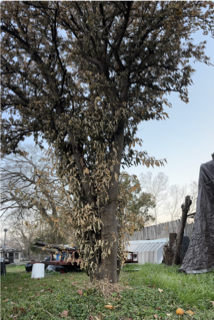From Picky Eater to Community Feeder: How a Southern Creole Girl Became an Urban Farmer and Food Justice Advocate
I was a sixteen-year-old homeschooled teen, and all I wanted was a summer job that wasn't soul-crushing retail or fast food. It felt like those were my only options until a parent from my mom’s co-op mentioned something completely unexpected: Eden Place, a Black-Owned nature center and farm right in Chicago.
I was instantly intrigued. I was a teenager obsessed with my hair, skin, and nails, spending hours learning about herbs and essential oils for the natural skincare line my parents and I had started when I was fourteen. The concept of growing ingredients wasn't entirely new; I'd even worked with a small Black-owned family apiary in Louisiana to source beeswax. At first, I figured Eden Place would just be a new place to source ingredients for our line.
The only person I'd ever seen truly care for plants was my grandpa. He had a small garden and a mandarin tree that I stubbornly insisted on calling an orange tree. We'd go back and forth about it and laugh every time. I loved that tree, but I never saw myself as someone who would grow anything beyond my natural hair. In fact, I hated bugs, the heat, and getting dirty. Yet, the idea of growing food in raised beds sounded both fascinating and like the last thing I ever expected to do.
But stepping into Eden Place was a revelation. It wasn't just a garden; it felt like a botanical sanctuary. The three-acre space, vibrant and overflowing, instantly pulled me in. I saw raised beds with collards and corn, hoop houses heavy with tomatoes, and open spaces with chickens, goats, Shetland ponies, native plants, bees, and even monarch butterflies—all in the heart of a disinvested neighborhood.
Seeing it thrive made the history of the place even more heartbreaking. Before it was this beautiful nature center, the three acres was an illegal dumpsite—a landscape of debris, waste, and neglect. When I saw the pictures of what it used to be, my heart broke. How could a community suffer that kind of neglect when other neighborhoods, including my own, were so different?
Michael Howard, the owner, didn't wait for outside help. He rallied his family and neighbors to transform the dumpsite themselves. They cleared the debris, planted food, and built a space where kids could connect with nature right in their own neighborhood. Eden Place wasn’t just growing food; it was growing restoration.
I quickly signed up for their Farm Apprenticeship Leadership Program with other local teens. I learned so much about agriculture and horticulture, but my favorite part was the hands-on work: planting, harvesting, and selling produce. I loved interacting with the seniors at the farmers market who would come specifically looking for turnip and mustard greens. For the first time, the weeds, the dirt, the bugs, and the heat didn't bother me. I felt like I was a part of something bigger than myself—a small fraction of helping the community improve their health. I marveled at how worms softened the soil for roots to take hold, and I even started eating vegetables I had never tried before, like fried green tomatoes. I began to see the land and soil not just as something beneath my feet, but as a relative. God was using the farm to show me that everything is connected and intentionally designed.
Growing up, I had internalized the idea that struggle was just part of being Black in America—that the fast food chains, liquor stores, and limited economic opportunities were simply the way things were. The farm gave me a name for what I had seen all my life but never fully understood: food apartheid. It’s more than a "food desert," which only describes an area with few grocery stores. Food apartheid points to the intentional, systemic inequities rooted in social, racial, and economic injustice. Policies like redlining and environmental racism had shaped our neighborhoods, leaving many without access to healthy, affordable, and culturally relevant food. For the first time, I could see the connection between history, policy, and the everyday reality of the people around me—and it changed the way I understood the world.
That summer, I also started watching documentaries like Food, Inc. and What the Health, and it felt like my eyes were opening wider than ever. The farm had taught me how to grow food; those films taught me why it mattered, showing me how climate change, greed, and broken systems were affecting our collective health. Once I saw it, I couldn’t unsee it. Feeding my community became my mission—a way to reclaim what has long been marginalized from us.
So, in the words of Ron Finley, the guerrilla gardener from South Central LA, who always says, “Go plant some shit.” Let it be the act of rebellion, resistance, and restoration all at once.
Grandpa’s Mandrain Tree in Baton Rouge
Vetiveah’s Skin Care
I ran a skincare product line from the time I was 16 until the end of college.







